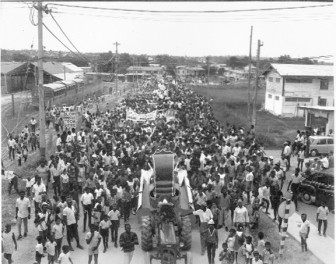From every nook and cranny they came. From down river they paddled their canoes, some came on horseback, others walked long distances and yet more came by bus as they congregated on Arvida Road, later known as Republic Avenue. It was indeed the Arvida bacchanal. It was Guyana’s first Mashramani celebrations.
The year was 1970. And the stage was well set in the bauxite town of Mackenzie. One year later, writing in the Foreward of the Souvenir Brochure of the Jaycees of Mackenzie, President Forbes Burnham acknowledged “that the people of Wismar, Mackenzie and Christianburg had provided the title for the National Celebrations, Mashramani.”

Burnham wrote: “I congratulate the community of Mackenzie, Wismar and Christianburg not only for having presented one of the most comprehensive programmes for the first anniversary celebrations but also for having provided the title for the celebrations – MASHRAMANI.”
He contended that the name “Mashramani” was particularly appropriate since it was one of the words used by Guyana’s indigenous people – the Amerindians – in reference to the celebrations which follow a successful completion of a community or co-operative project or enterprise.
Some 41 years later many celebrate Mashramani but are uncertain of its origin or of the circumstances that are responsible for the observance of the Republic’s anniversary in carnival style on February 23 each year.
Several names may come into focus with the observance of the first Mashramani celebrations. But Jim Blackman, Hernan Nobriga and Jimmy Hamilton will always stand out. Indeed, the names of these three should be ingrained in our nation’s history for the carnival type observances of the Republic Anniversary.
The very name of Mashramani should be viewed as being accidental. The Amerindians were known to travel for long distances using canoes down river as they gathered for birthdays or weddings. Ongoing research by the group later proved that a name was given to the celebrations. But the young Jaycees as they were then, found no evidence of the writing of the word, depicting a celebration after the successful completion of a project or enterprise – Mashramani.
Together they knocked their heads as they sought a solution. Even the oldest Amerindian found alive heard the word, Mashramani but had never seen it in writing – no one knew for sure how the word was spelt. The men were spellbound as the time for the celebrations drew near; it was four years after this country had rid itself of the colonial masters – Great Britain – and was about to begin the journey for economic independence. It was at this point that Jaycees Chairman, Jimmy Hamilton hazarded a guess and to date the spelling of Mashramani remains the same.
Also involved in the first anniversary celebrations were Burton Gilbert who took on the major task of being responsible for all dances, William “Bill” Harris, Finance Officer, and Raymond Hayes, the Project Manager who was responsible for Shanto Preliminaries and Finals.
In addition, there were Victor Smith, at the time Project Manager, J.N. “Nic” Adams, the Public Relations Officer, Chubby Hoe, Eileen Bowen, assistant to the Chairman and recording secretary, Rannie Anthony, Project Manager for Stage and Construction, replacing Bobby Alstrom who had fallen ill, and Claude Saul who had taken on the responsibility for Protocol and Security.
Initially, the men had gathered for the fourth Independence Anniversary with a Carnival celebrations in mind, but found a greater challenge as it was confirmed that Guyana was to become a Republic.
In the words of Hamilton, his organization was initially responsible for the Independence celebrations in the Mackenzie area. He recalled that “Inspired by the success of two Independence Carnivals, the Jaycees of Greater Mackenzie launched the birth of the Co-operative Republic with Mashramani in 1970 and at the same time adopted the theme of co-operation and leadership for a dynamic republic.
“Now for the first anniversary in Guyana’s Republic we can feel justly proud of our theme and “MASHRAMANI’.”
The Mayor of Christianburg, Wismar and Mackenzie township later known as Linden, was not left out. He opined that “the community has matured into a township.” He further stated, “I appreciate that the JAYCEES in the continued effort to improve the area has encouraged the young men and young women to play a greater role in the civic life of the area and has encouraged them to play a greater role since there is much the young people could do if given the right stimulus.”
The first celebration indeed took the bauxite community by storm. They came pouring in to the Mackenzie township. The people of Kwakwani, Ituni and Everton joined their colleagues as they sought to occupy common ground for the series of nationalization events to follow. For its part, the Bauxite Management at Mackenzie encouraged participation through the company and this was to be repaid at the meagre rate of one Guyana dollar per month.
The Mackenzie bacchanal was Trinidad-like in its outlook. For one thing the term, Shanto was subsidized, instead of Calypso as is known in Trinidad. The Mackenzie JAYCEES also decided on the use of ‘fore-day’ morning instead of J’ouvert or Jouvay as in Trinidad.
The more than a thousand revellers who made up the band of the first Mash exceeded the projected number within weeks of launching the programme.
The buses to and fro could be heard all hours at night and unto the wee hours of the morning as the people from the bauxite communities wended their way to Mackenzie, all in the mood to celebrate the first Mash in Guyana.
Meantime, in Georgetown a candlelight march, a Joint Services parade and masquerade bands as well as fireworks highlighted the observance in the capital.








